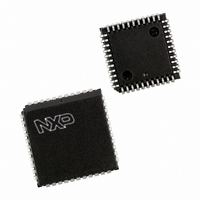P89C662HBA/00,512 NXP Semiconductors, P89C662HBA/00,512 Datasheet - Page 15

P89C662HBA/00,512
Manufacturer Part Number
P89C662HBA/00,512
Description
IC 80C51 MCU FLASH 32K 44-PLCC
Manufacturer
NXP Semiconductors
Series
89Cr
Datasheet
1.P89C660HBA00512.pdf
(89 pages)
Specifications of P89C662HBA/00,512
Core Processor
8051
Core Size
8-Bit
Speed
33MHz
Connectivity
I²C, UART/USART
Peripherals
POR, PWM, WDT
Number Of I /o
32
Program Memory Size
32KB (32K x 8)
Program Memory Type
FLASH
Ram Size
1K x 8
Voltage - Supply (vcc/vdd)
4.5 V ~ 5.5 V
Oscillator Type
Internal
Operating Temperature
0°C ~ 70°C
Package / Case
44-PLCC
Lead Free Status / RoHS Status
Lead free / RoHS Compliant
Eeprom Size
-
Data Converters
-
Other names
568-1269-5
935267444512
P89C662HBA
935267444512
P89C662HBA
Available stocks
Company
Part Number
Manufacturer
Quantity
Price
Company:
Part Number:
P89C662HBA/00,512
Manufacturer:
NXP Semiconductors
Quantity:
10 000
Philips Semiconductors
Arbitration and Synchronization Logic
In the Master Transmitter mode, the arbitration logic checks that
every transmitted logic 1 actually appears as a logic 1 on the I
bus. If another device on the bus overrules a logic 1 and pulls the
SDA line low, arbitration is lost, and SIO1 immediately changes from
master transmitter to slave receiver. SIO1 will continue to output
clock pulses (on SCL) until transmission of the current serial byte is
complete.
Arbitration may also be lost in the Master Receiver mode. Loss of
arbitration in this mode can only occur while SIO1 is returning a “not
acknowledge: (logic 1) to the bus. Arbitration is lost when another
device on the bus pulls this signal LOW. Since this can occur only at
the end of a serial byte, SIO1 generates no further clock pulses.
Figure 4 shows the arbitration procedure.
2002 Oct 28
80C51 8-bit Flash microcontroller family
16KB/32KB/64KB ISP/IAP Flash with 512B/1KB/2KB/8KB RAM
SDA
SCL
SDA
SCL
1. Another device transmits identical serial data.
2. Another device overrules a logic 1 (dotted line) transmitted by SIO1 (master) by pulling the SDA line low. Arbitration is
3. SIO1 is in the slave receiver mode but still generates clock pulses until the current byte has been transmitted. SIO1 will
1. Another service pulls the SCL line low before the SIO1 “mark” duration is complete. The serial clock generator is immediately
2. Another device still pulls the SCL line low after SIO1 releases SCL. The serial clock generator is forced into the wait state
3. The SCL line is released, and the serial clock generator commences with the mark duration.
lost, and SIO1 enters the slave receiver mode.
not generate clock pulses for the next byte. Data on SDA originates from the new master once it has won arbitration.
reset and commences with the “space” duration by pulling SCL low.
until the SCL line is released.
DURATION
MARK
1
(1)
(1)
Figure 5. Serial Clock Synchronization
Figure 4. Arbitration Procedure
2
(1)
SPACE DURATION
2
C
3
15
(2)
The synchronization logic will synchronize the serial clock generator
with the clock pulses on the SCL line from another device. If two or
more master devices generate clock pulses, the “mark” duration is
determined by the device that generates the shortest “marks,” and
the “space” duration is determined by the device that generates the
longest “spaces.” Figure 5 shows the synchronization procedure.
A slave may stretch the space duration to slow down the bus
master. The space duration may also be stretched for handshaking
purposes. This can be done after each bit or after a complete byte
transfer. SIO1 will stretch the SCL space duration after a byte has
been transmitted or received and the acknowledge bit has been
transferred. The serial interrupt flag (SI) is set, and the stretching
continues until the serial interrupt flag is cleared.
(2)
4
P89C660/P89C662/P89C664/
(3)
(3)
(1)
8
ACK
9
P89C668
SU00967
SU00968
Product data
















